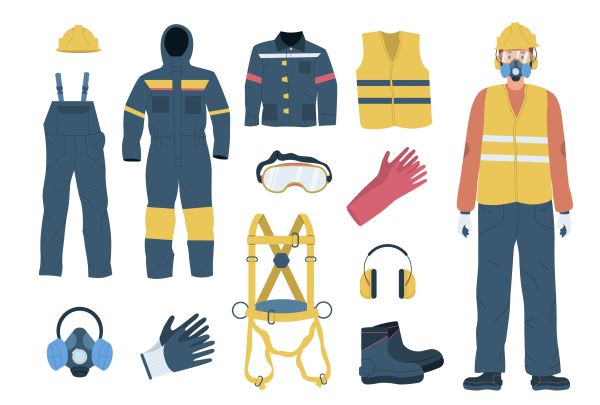“Essential Guide to Protective Clothing: Ensuring Safety & Comfort”
Protective clothing is crucial for ensuring the safety and well-being of employees in various industries. It serves multiple purposes beyond just protection from dirt and tears; it also promotes a professional image for your company and fosters a sense of unity among employees.
As an employer, ensuring the safety and well-being of your employees should be a top priority. Employees deserve to feel secure, comfortable, and unrestricted in their movements. Therefore, providing proper protective clothing is crucial, ensuring they do not have to compromise on these aspects.
In this blog, we will explore the significance of protective clothing and discuss key considerations to keep in mind when purchasing it.
Importance of Protective Clothing
1. Safety and Protection
The first and foremost function of protective clothing is to protect the workers from the hazardous workplaces. Especially in the industries like construction, manufacturing and healthcare where employees are exposed to hazardous chemicals, heat, electricity and physical injuries.
2. Enhanced Company Image
Workwear uniforms create a unified and professional look. When your company’s logo is featured, it reinforces brand identity and instills confidence in both employees and clients.
3. Comfort and Productivity
Ensuring employees comfort at work place is as crucial as their safety. A well-designed protective clothing does both the job. Comfortable clothing can boost employee morale and productivity by allowing them to focus on their tasks without discomfort or distraction.
4. Compliance and Regulations
Many industries have specific regulations regarding the type of protective clothing that must be worn. Adhering to these regulations not only ensures legal compliance but also demonstrates your commitment to safety standards.
Types of Protective Clothing
Protective clothing comes in various types and forms, each designed to provide specific protection depending on the hazards present in the workplace. Here are some common types of protective clothing:
a). Chemical Protective Clothing
Designed to protect against chemical spills, splashes, and exposure. It includes suits, coveralls, aprons, and gloves made from materials such as neoprene, PVC, rubber, or Tyvek.
b). Fire-Resistant (FR) Clothing
Used in environments where there is a risk of fire or electric arc flash. FR clothing is made from flame-resistant materials such as treated cotton, Nomex, Kevlar, or blends like Modacrylic.
c). High-Visibility Clothing
Also known as Hi-Vis clothing, it includes vests, jackets, and coveralls with fluorescent colors (typically yellow, orange, or red) and reflective tapes. It enhances visibility in low-light conditions, reducing the risk of accidents in construction, roadwork, and other high-risk areas.
d). Protective Outerwear
Includes jackets, coats, and parkas designed to provide weather protection and insulation while also incorporating safety features such as high-visibility strips or reflective materials.
e). Protective Footwear
Boots and shoes designed to protect against specific workplace hazards such as slips, impacts, punctures, and chemical exposures. They may include steel-toe caps, metatarsal guards, or chemical-resistant soles.
f). Eye and Face Protection
This includes safety glasses, goggles, face shields, and welding helmets designed to protect against flying debris, chemicals, sparks, and UV radiation.
g). Head Protection
Hard hats or helmets protect against head injuries from falling objects, impacts, and electrical hazards. Some variants include accessories like face shields and earmuffs for additional protection.
h). Respiratory Protection
Includes masks and respirators designed to filter out airborne contaminants such as dust, fumes, gases, and vapors. Respiratory protection is crucial in environments where air quality may be compromised.
i). Body Support and Ergonomic Clothing
This category includes back supports, knee pads, and ergonomic clothing designed to reduce strain and prevent musculoskeletal injuries during repetitive or physically demanding tasks.
j). Biological Hazard Protection
Used in healthcare and laboratory settings to protect against biological hazards such as pathogens. Includes gowns, coveralls, masks, gloves, and shoe covers made from impermeable materials.
Each type of protective clothing is selected based on the specific hazards present in the workplace and the level of protection required to ensure the safety and well-being of employees.
Tips for Purchasing the Right Protective Workwear
When selecting protective clothing for your employees, consider the following factors:
- Identify Specific Hazards
Assess the specific hazards your employees face in their work environment. This will help you determine the appropriate level of protection required, whether it’s for chemical spills, fire resistance, high-visibility needs, etc.
- Comfort and Fit
Choose garments that are comfortable and allow for freedom of movement. Employees are more likely to wear protective clothing consistently if it fits well and doesn’t restrict their movement.
- Durability and Maintenance
Look for durable fabrics and construction that can withstand the rigors of the work environment. Consider ease of maintenance and laundering requirements to ensure longevity.
- Visibility and Branding
For industries where visibility is crucial (like construction or roadwork), opt for high-visibility colors and reflective materials. Incorporate your company’s logo prominently to enhance brand visibility.
- Employee Input
Involve employees in the selection process whenever possible. Their feedback on comfort and practicality can provide valuable insights into choosing the right protective clothing.
- Supplier Reliability
Choose reputable suppliers who provide quality workwear and can offer guidance on compliance with industry standards and regulations.
Conclusion
Investing in protective workwear isn’t just about meeting safety requirements; it’s about creating a safer, more professional work environment where employees feel valued and productive. By prioritizing safety, comfort, and branding, you can enhance both workplace safety and company image effectively.
Follow Us On
Facebook | Instagram | LinkedIn | Twitter | Google My Business




